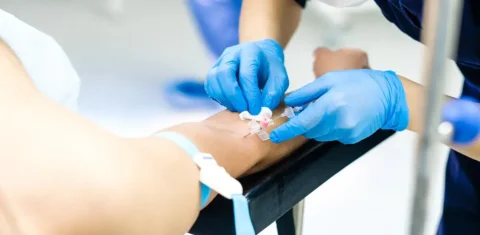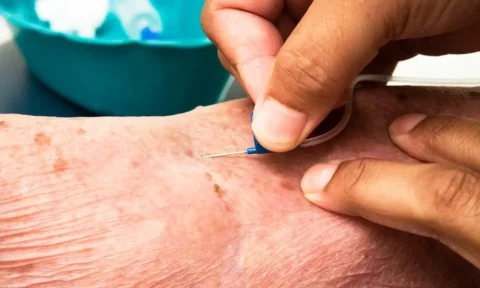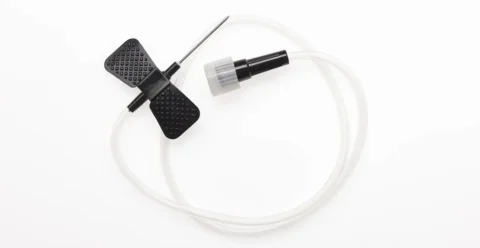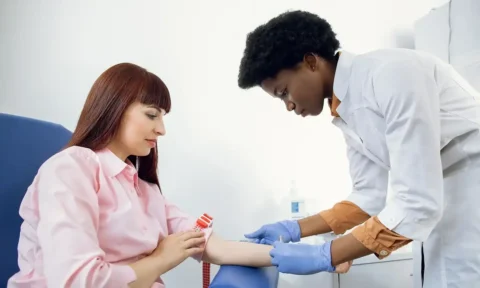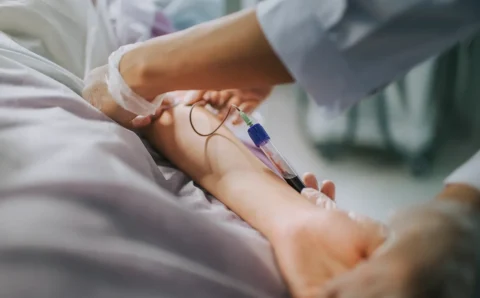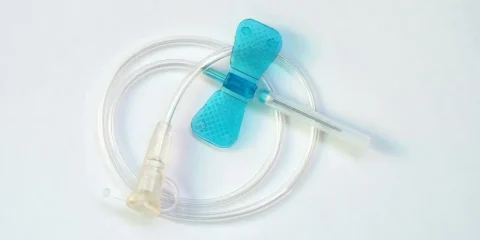There are a variety of medical techniques and instruments that can be used to collect blood specimens. Normally, the selection of needle device for venipuncture varies depending on the patient’s age, medical history, and vein health. The butterfly needle is best used for blood draw in an individual with a bleeding disorder or among the pediatric and geriatric population.
So how is blood collection performed using a butterfly needle? First, locate the vein where the venous blood will be drawn. A tourniquet may be used to apply pressure and make the veins easier to identify. Disinfect the insertion site and as it dries, attach the butterfly needle to a tube holder. Hold the patient’s hand and anchor the vein to stretch the skin so the needle enters smoothly. You’ll see blood flowing in the tubing and wait until it fills up the blood collection tube.
How to Properly Use A Butterfly Needle for Blood Collection
Venipuncture, or blood collection, is a medical procedure that’s done for a variety of purposes. The most common reason is to monitor the blood sample to check a patient’s health condition and diagnose if they have existing diseases. It may also be done to donate blood or remove excess blood volume, red blood cells, and iron to achieve balance in fluids.
This procedure can also be done in aesthetic practices to administer procedures such as platelet rich plasma injections. This autologous treatment uses a solution of blood platelets and growth factors to accelerate wound healing and improve the appearance of the skin and scalp.
A phlebotomist has three common options for performing venipuncture: straight needle and syringe, evacuated tube systems, and winged infusion sets. There are several factors that affect the selection of the blood collection system, such as the patient’s age and the location of the vein. If the intended collection site has smaller veins, a winged infusion set should be used.
What Is A Butterfly Needle?
Butterfly needles are also called winged infusion or scalp vein sets. This type of blood collection device consists of a thin hypodermic needle with a plastic sheath, flexible wings, transparent tubing, and a connector. When extracting a blood sample, the connector is typically attached to another medical tool such as a syringe, tube holder, or vacuum tube. Some butterfly needles also have a Luer lock which secures it in its position.
The size of butterfly needles is typically measured in gauges. Phlebotomists can choose from 18 to 27 needle gauges depending on the procedure that will be performed. The most commonly used needle sizes for blood collection are 21- and 23-gauge needles since they can collect more blood in a short amount of time.
Step-by-Step Guide on How to Draw Blood Using A Butterfly Needle
Blood collection is a fairly simple and straightforward medical procedure. Generally, the first step involves verifying the patient’s identity and reviewing their request to know the purpose of the blood collection. This will also help you to properly label the blood specimen and prepare it for lab testing once the extraction is complete.
After patient identification, you can start preparing for the venipuncture procedure. Here’s an overview of how to properly administer blood collection with a butterfly needle:
1. Prepare your winged infusion set for blood draw
First, you need to get all the equipment you need for the blood collection process. This includes the butterfly needle and either the syringe or ETS holder for the specimen. Always check the sterility of the butterfly needle and inspect the validity of the blood collection tubes.
If it’s way past the expiration date, the vacuum tube may not be able to draw the required amount of blood. Additionally, you should also keep the sheath or cover of the needle to keep its sterility before use.
2. Look for the vein in the patient’s arm
Take the patient’s arm and gently position it on an armrest for support. You may have to ask the patient to bend their fingers or make a fist to make the veins more visible. Apply a clean tourniquet at least 2 to 4 inches from where you plan to make the insertion site. This will help build up blood pressure in the arm and make the veins easier to penetrate with the hollow needle.
3. Cleanse and disinfect the needle insertion site
The next step is to disinfect the needle insertion area with a clean pad and 70% isopropyl alcohol. Make sure you’re wearing hand gloves as you wipe the skin where you plan to pierce the butterfly needle. The recommended way to cleanse the area is by starting at the center point of the needle entry and moving the alcohol-soaked pad in a circular motion going outward to push the dirt and debris.
Cleaning the insertion site is an essential step in venipuncture procedures to reduce the risk of infections from microorganisms that may enter the skin. Allow the skin to air dry for 30 seconds to a minute before puncturing the vein. Attach the butterfly needle to the ETS holder and insert the tube to get ready for the blood collection.
4. Insert the butterfly needle into the superficial vein
Once the insertion area is dry, re-apply the tourniquet on the patient’s arm to make the needle entry easier. Hold the winged portion of the needle with your index and thumb fingers and position the tubing and holder next to the patient. Remove the plastic sheath and inspect the butterfly needle for defects.
Upon checking that the needle is clean and sterile, grasp the patient’s skin and stretch it lightly to aid the needle entry. Thanks to its flexible tubing, you can puncture the needle into the vein at a shallow angle of at least 10 to 15 degrees. You’ll notice a flash of blood in the needle hub which indicates successful venous access.
Place a collection tube in the holder and push it onto the needle with a clockwise twist to start the blood flow. If you’re doing a coagulation test with a clot activator, you should draw a discard tube first to withdraw the air in the tubing to avoid getting an underfilled tube.
5. Remove the tourniquet and needle once the tube is full
Monitor the collection tube and wait for the blood to fill it from the bottom up. Once it’s complete, release the tourniquet and remove the tube from the holder. Get a clean gauze pad and place it over the insertion site so it can immediately cover the skin and control bleeding once the butterfly needle is removed.
Pull the needle in one swift motion and quickly place the gauze and apply pressure for a few seconds to stop the bleeding. Winged infusion sets have a safety device that allows them to safely retract the needle to avoid accidental needle sticks.
Normally, you have to press a push button to activate the retraction mechanism and withdraw the needle. You can also manually pull the tubing by hand to retract the needle. Avoid placing the used needle on the work table and discard them in the sharps container.
How Long Does It Take to Get Blood Drawn With A Butterfly Needle?
A winged infusion set has a smaller needle compared to other blood collection systems. While blood draw with a straight needle can take less than 2 minutes, you can expect blood collection with a butterfly needle to be longer. Even with a higher needle gauge, the blood flow will still be slower compared to the average needle size.
This may not be an ideal needle type in situations where blood collection or transfusion is needed immediately. Additionally, a phlebotomist may have a difficult time obtaining large quantities of blood with a butterfly needle.
What Kind of Veins Are Butterfly Needles Used For?
The most common sites for venipuncture are the cephalic, median cubital, and basilic vein. But do note that the small size of butterfly needles makes them more appropriate for insertion to a superficial or small vein.
Winged infusion sets are also ideal for blood collection among elderly patients with narrow or rolling veins that can be difficult to access with a large needle. Butterfly needles can also be inserted into the small veins of the hands, feet, and scalp.
Aside From Blood Collection, When Do You Use A Butterfly Needle?
Although butterfly needles are smaller than an IV catheter, doctors also use them for administering intravenous therapy. A winged infusion set may be chosen to create intravenous access with a butterfly needle to deliver IV medications.
It can also be used in wellness and aesthetic practices to provide IV infusion therapies. However, if the butterfly needle is being used for the delivery of IV fluid, make sure to not leave them inside the vein for more than 5 hours. Otherwise, if a patient requires regular infusion, you may need to establish a central line through a larger vein with another needle device.
What’s The Difference Between a Butterfly Needle and a Regular Needle?
The main difference between a butterfly and a regular needle is their size. Winged infusion sets are shorter than straight needles and they have flexible tubing that allows a phlebotomist to access superficial veins at a shallow angle.
Butterfly needles also offer a less painful blood collection experience for patients. This makes it a suitable needle choice for individuals who are scared of sharp needles. Most newer types of butterfly needles also have a safety device that automatically retracts the needles to lessen the risk of bleeding, vein collapse, nerve damage, and needlestick injury.
Here are the other benefits of butterfly needle over other methods for blood draw:
- The wings on the sheath help stabilize the needle once it’s been inserted into the veins, reducing the risk of a needle stick injury.
- It’s a versatile injection device that can be used for blood draws, infusions, and transfusions.
- You can visually monitor the blood flow with its transparent tubing.
- Its safety locks are easy to activate so the whole blood draw process is safer for the phlebotomist and patient.
Buy Quality, Medical-Grade Butterfly Needle Sets at FACE Med Store
Butterfly needles are very convenient to use for taking blood samples in both elderly and young patients. Its small size and flexible tubing let you administer a comfortable venipuncture procedure and reduce the risk of damage and infections from needles.
FACE Med Store is a trusted provider of high-quality medical tools and supplies for medical and aesthetic procedures. We offer different gauges and tubing lengths of butterfly needles for your blood extraction and infusion services. Contact us now to inquire about our stocks or check our product page to find more instruments that you may need for your practice.
